A visit to the 9/11 Memorial is a must when visiting New York. This place of remembrance, located at Ground Zero, pays tribute to the victims of the attacks of 11 September 2001 and 1993. Inaugurated on 11 September 2011, exactly ten years after the tragic events, this commemorative site offers visitors a place to remember and understand the scale of this tragedy that marked the history of the United States and the whole world. Access to the memorial is entirely free, allowing everyone to come and pay their respects, whatever their financial circumstances.
The memorial complex is more than just a monument. It is a collection of memorial sites, public spaces and infrastructures that collectively tell the story of the attacks, honour the memory of the victims and bear witness to the resilience of New York City.
The main elements of the Memorial
The memorial pools
At the heart of the 9/11 Memorial are two huge pools built exactly where the Twin Towers of the World Trade Center once stood. These pools, measuring an impressive 54 x 54 metres, represent 69% of the original size of the towers. Spectacular cascades of water flow down their walls, creating a soothing soundscape that contrasts with the surrounding urban tumult.
The bronze parapets surrounding each pool are engraved with the names of the 2,983 victims of the 11 September 2001 attacks and the 1993 bombing of the World Trade Center. These names are not listed at random, but organised according to a system of ‘constellations’ based on the relationships between the victims – colleagues, friends, family – creating an emotional map of the human bonds broken that day. A touching detail: each name is cut through the metal, allowing visitors to touch the letters and place a flower in tribute.
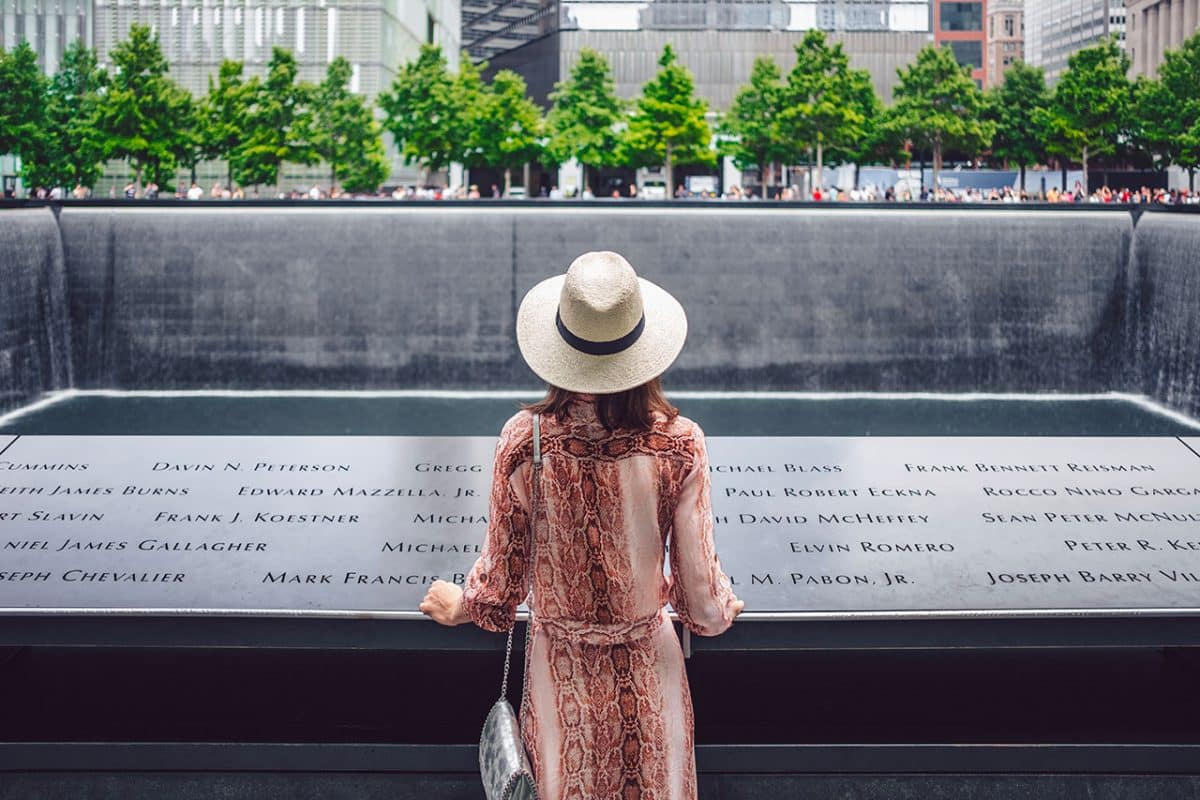
The Memorial Plaza
Surrounding the pools is the Memorial Plaza, a peaceful area planted with 415 trees. Among them, one oak in particular stands out: the“Survivor Tree“. This tree, discovered in the rubble in October 2001 with just one branch still alive, was carefully preserved and cared for for months before being replanted in 2010 near the South Basin. Today, this robust oak tree symbolises rebirth and resilience in the face of adversity.
Memorial Plaza offers a striking contrast to the busy streets of Lower Manhattan. Despite its location in the heart of one of New York‘s most dynamic districts, it is a place that invites calm and reflection. Benches scattered throughout the space allow visitors to sit and contemplate the pools, creating a moment’s pause in the frenetic pace of the city.
Nearby memorial sites
The 9/11 Memorial Glade
Next to the South Basin is the 9/11 Memorial Glade, a monument added more recently to honour all those who fell ill or died as a result of the attacks. This memorial pays tribute to the first responders, reconstruction workers, residents and all those who suffered ailments linked to exposure to the toxins present on the site after the attacks.
Comprising six massive monoliths that appear to rise from the ground, the Memorial Glade symbolises the strength and determination shown by these individuals. Each monolith is pierced by fragments of steel salvaged from the Twin Towers, establishing a tangible link with the original structures.
The FDNY Memorial Wall
Diagonally across the main Memorial, against the wall of Fire Station Ladder 10, stands the FDNY Memorial Wall. This bronze work of art pays tribute to the 343 firefighters who lost their lives trying to save others on 11 September 2001.
The memorial features a representation of the Twin Towers at its centre and illustrates all the vehicles and equipment mobilised that day. A chronology of events is presented, allowing visitors to follow the unfolding of that tragic day. For many New Yorkers, this memorial is particularly moving because it honours those who went into the towers while everyone else was coming out.
Liberty Park
Overlooking the September 11th Memorial and the Freedom Tower, Liberty Park offers a different perspective on the site. In this elevated park, visitors can observe two significant elements: “The Sphere” and the St. Nicholas National Shrine.
“The Sphere, an imposing bronze sculpture by Fritz Koenig, originally stood on the plaza between the twin towers. Although damaged during the attacks, it survived and, after meticulous restoration, found its place in Liberty Park. Its visible scars are a poignant reminder of the violence of the events.
St. Nicholas National Shrine is a Greek Orthodox church rebuilt after the original building was destroyed in the attacks. Its new architecture, with its illuminated dome, adds a spiritual dimension to the whole memorial site.
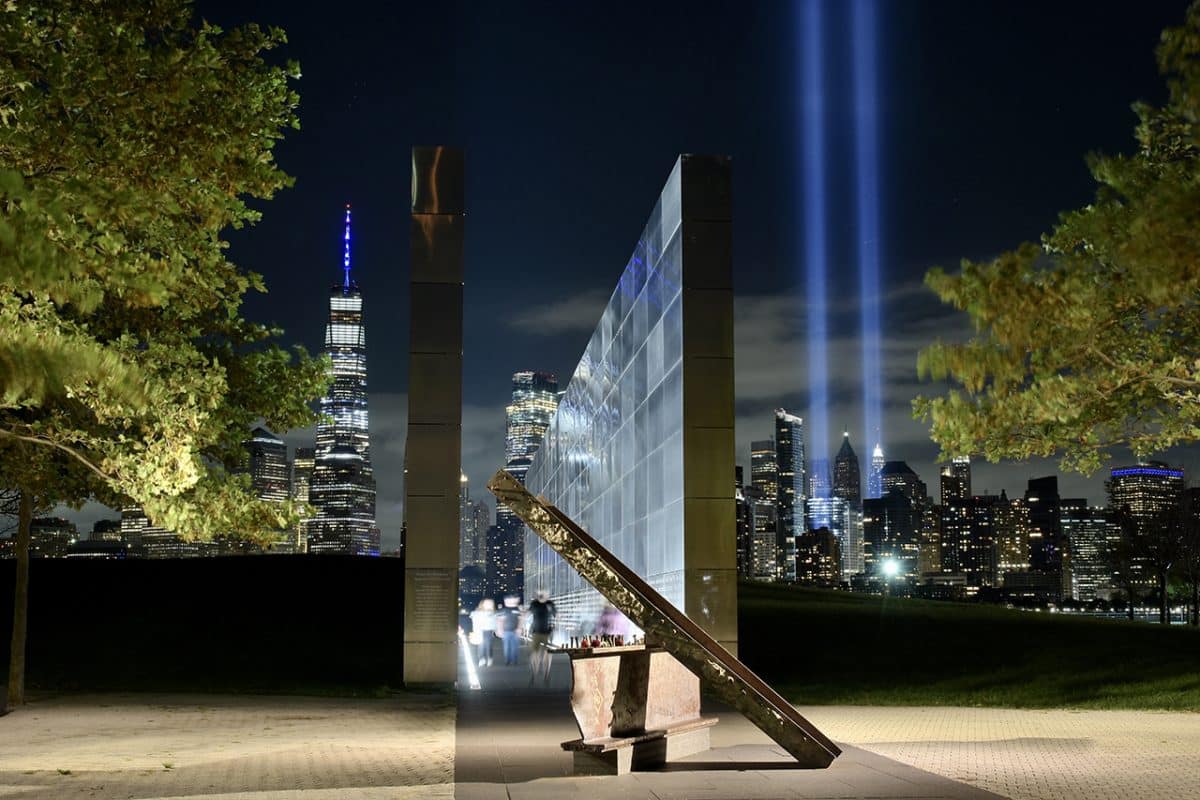
The Oculus: an architectural marvel
Just a stone’s throw from the Memorial stands the Oculus, a spectacular structure designed by the architect Santiago Calatrava. This white building, which looks like a gigantic bird ready to take flight, is not only an architectural masterpiece, but also fulfils two essential functions: it is both a shopping centre and a station linking several metro and train lines.
The interior of the Oculus is simply majestic, with its immense central space bathed in natural light. A fascinating architectural detail: an opening was specially designed in the roof to let in a ray of sunlight on 11 September at exactly 10.28am, the precise time when the second tower collapsed. This ray of light then passed through the entire building, creating a moment of silent communion.
When you visit the Memorial, take the time to enter the Oculus. Its interior architecture is well worth a visit, even if you don’t plan to go shopping or take public transport.
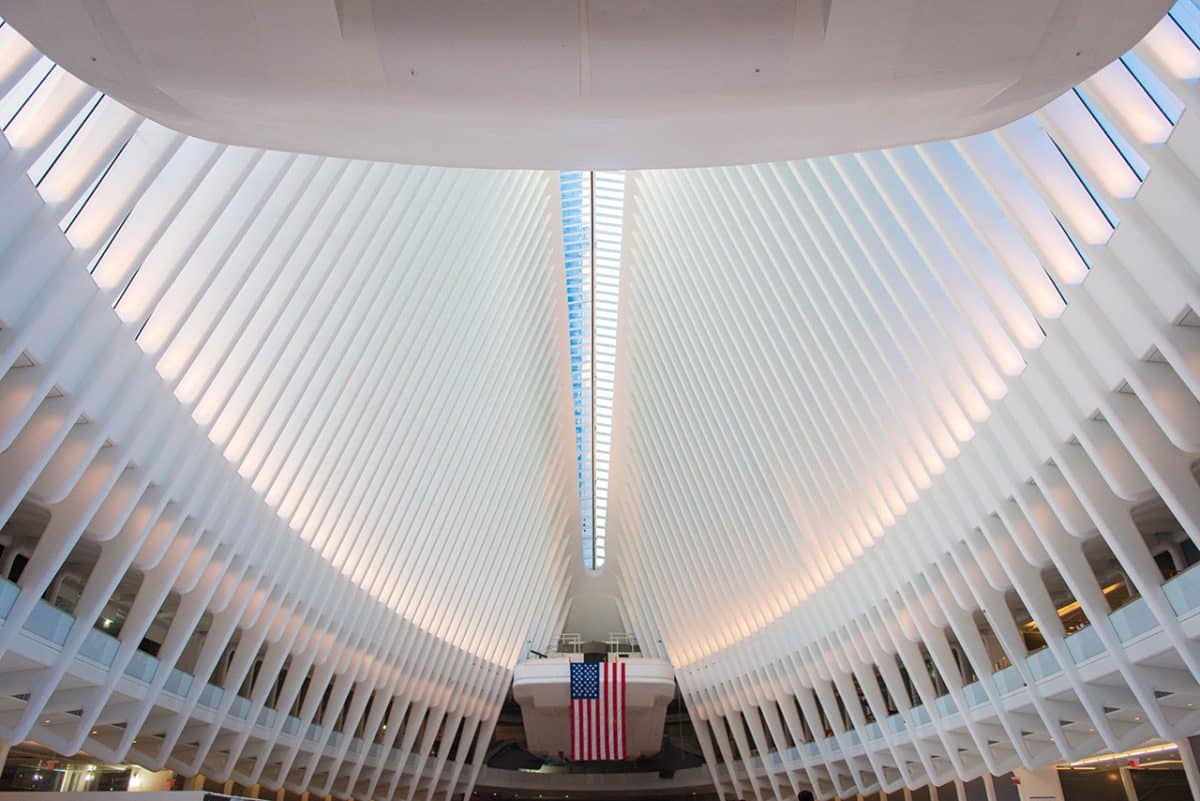
The 11 September Museum
Complementing the Memorial, the 11 September Museum offers an in-depth immersion in the events of that tragic day. Situated 21 metres below the level of the Memorial, the museum is built around the original foundations of the Twin Towers, integrating authentic remains into its layout.
Open Wednesday to Monday from 10am to 5pm, the museum houses a remarkable collection of objects recovered from the rubble: steel pillars twisted by the heat and impact, firefighters’ helmets, a burnt-out fire engine, and many personal effects of the victims. These artefacts, presented with respect and sensitivity, tell the human story behind the tragedy.
The museum tour includes audio and video testimonies from survivors and victims’ families, creating an immersive and moving experience. A space is dedicated to each of the victims, with photos and personal objects, humanising the toll of the attacks.
Unlike the Memorial, admission to the museum is not free. You should allow at least two hours for your visit, although many visitors spend half a day there, as the content is so rich and well worth a look.
One World Trade Center
Rising majestically next to the Memorial, the One World Trade Center, commonly known as the Freedom Tower, symbolises New York’ s renewal after the tragedy. At 541 metres (1,776 feet, in reference to the year of the American Declaration of Independence), it is the tallest building in the United States and the entire Western Hemisphere.
On the 102nd floor of the skyscraper is the One World Observatory, an observation platform offering breathtaking views of Manhattan, Brooklyn, New Jersey and beyond. From this height, visitors can admire the Statue of Liberty, the Brooklyn Bridge and New York’s entire urban landscape. The lift leading up to the observatory is an experience in itself: its walls are screens showing the evolution of Manhattan over the centuries as they rise.
The Freedom Tower is not just a spectacular vantage point; it is a powerful symbol of American resilience and New York’s determination to bounce back after the attacks.
Annual commemorative events
Tribute in Light
Every year on the evening of 11 September, New York pays a luminous tribute to the victims with the“Tribute in Light“. Two powerful blue beams are projected into the sky from Lower Manhattan, creating the illusion of two columns of light rising in place of the lost towers.
Visible from many points in the city and even the surrounding area, these beams of light were switched on at 6pm on 11 September and remained visible until dawn the following day. For amateur and professional photographers alike, this is an ideal time to capture striking images of the New York skyline.
11 September ceremony
On the anniversary of the attacks, a private ceremony is organised for the families of the victims at the Memorial. During this event, the names of all the victims are read out, often by their relatives, with moments of silence observed at the exact times when the planes hit the towers and the buildings collapsed.
On this day, exceptionally, the memorial is closed to the public until 3pm, then remains open until midnight, allowing New Yorkers and visitors to come and pay their respects in the evening, often under the Tribute in Light.
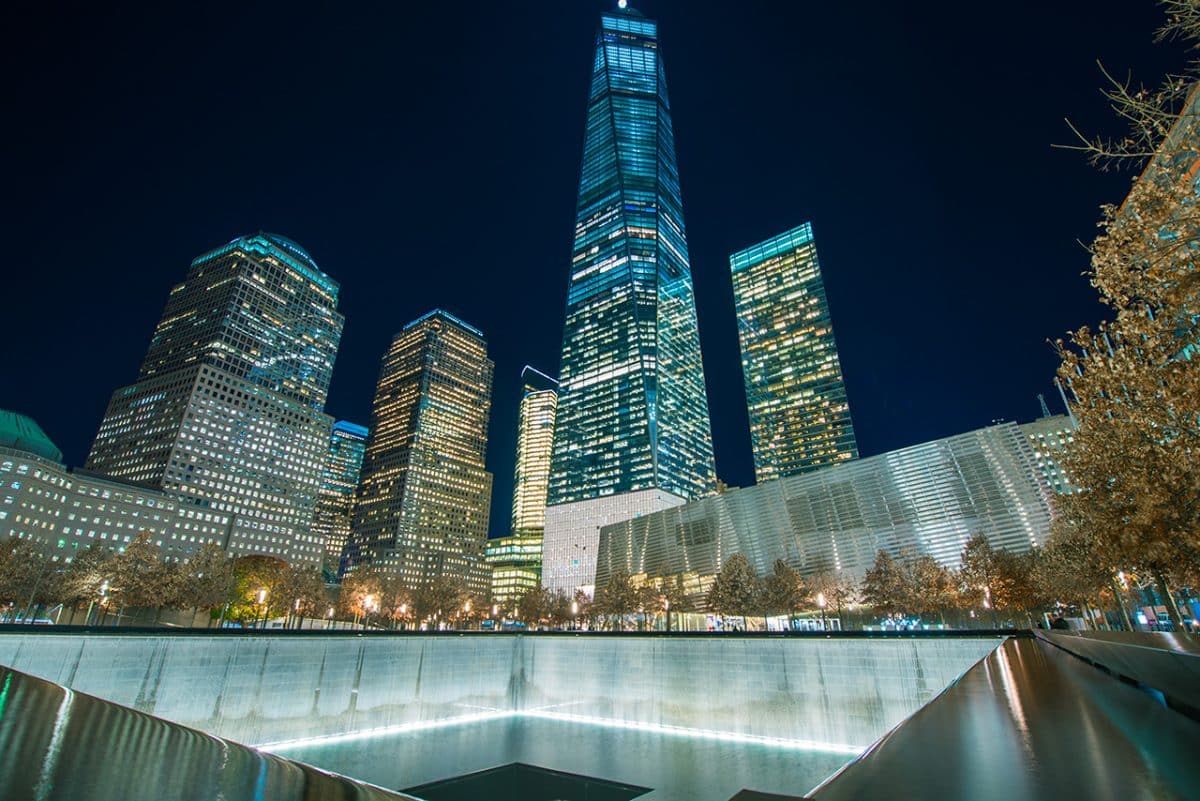
Practical information for your visit
Opening times and access
The 11 September Memorial is open every day from 8am to 8pm, except on Tuesdays when it remains closed. Please note that it is impossible to access the memorial pools outside opening hours – you will only be able to see them from a distance.
By metro
The quickest and most convenient way to get there is by tube.
- Line R: Cortlandt Street station (nearest)
- Line 1: Rector Street station
- Line E: World Trade Center station
- A, C, J, Z, 4, 5 lines: Fulton Street station
From the tube exit, head towards Church Street, then look out for theOculus (impossible to miss with its distinctive white structure). The Memorial is right next door.
By bus
- M5 Southbound: get off at Broadway and Thames Street
- M5 Northbound: get off at Trinity Place and Rector Street
- M20 Southbound: get off at South End Avenue between Liberty Street and Albany Street
- M22 Southbound: get off at Vesey Street between North End Ave. and West Street
The Memorial and Museum are located on the site of the World Trade Center in Manhattan at 180 Greenwich St. Visitors can access the Memorial at the intersection of Liberty St and Greenwich St.
With the PATH
The PATH train serves the World Trade Center terminal from several points in New Jersey.
Admission to the museum costs $24 for adults and $15 for children.
Save on your visit to Memorial 9/11
The Memorial 9/11 & Museum is available in 4 Passes, order one of them to visit attractions at the best prices.
Guided tours
Although access to the Memorial is free, opting for a guided tour can greatly enhance your experience. Tours of 1? to 2 hours are offered regularly, led by expert guides who share stories and details you might not otherwise find.
Some tours include access to the 9/11 Museum, while others combine the Memorial with a tour of the surrounding Financial District, providing a broader context of the area affected by the attacks.
For a truly comprehensive guided tour, book in advance, especially during the peak tourist season (summer and holiday periods).
Tips for a respectful visit
The 11 September Memorial is no ordinary tourist attraction, but an emotional place of remembrance for many people. Here are some recommendations for a respectful visit:
- Maintain a calm and respectful attitude
- Keep your voice low
- Smiling selfies or happy poses are considered inappropriate
- You may take photos, but without flash
- You are allowed to bring small bottles of water and snacks
- Do not touch the engraved names with pens or objects that could damage them
The best time to visit the Memorial is in the late afternoon or evening, when the pools are illuminated and the tourist crowds are easing off. The atmosphere is particularly moving as night falls.
Allow plenty of time – at least an hour for the Memorial alone, and half a day if you want to include the museum and surrounding sites in your visit.
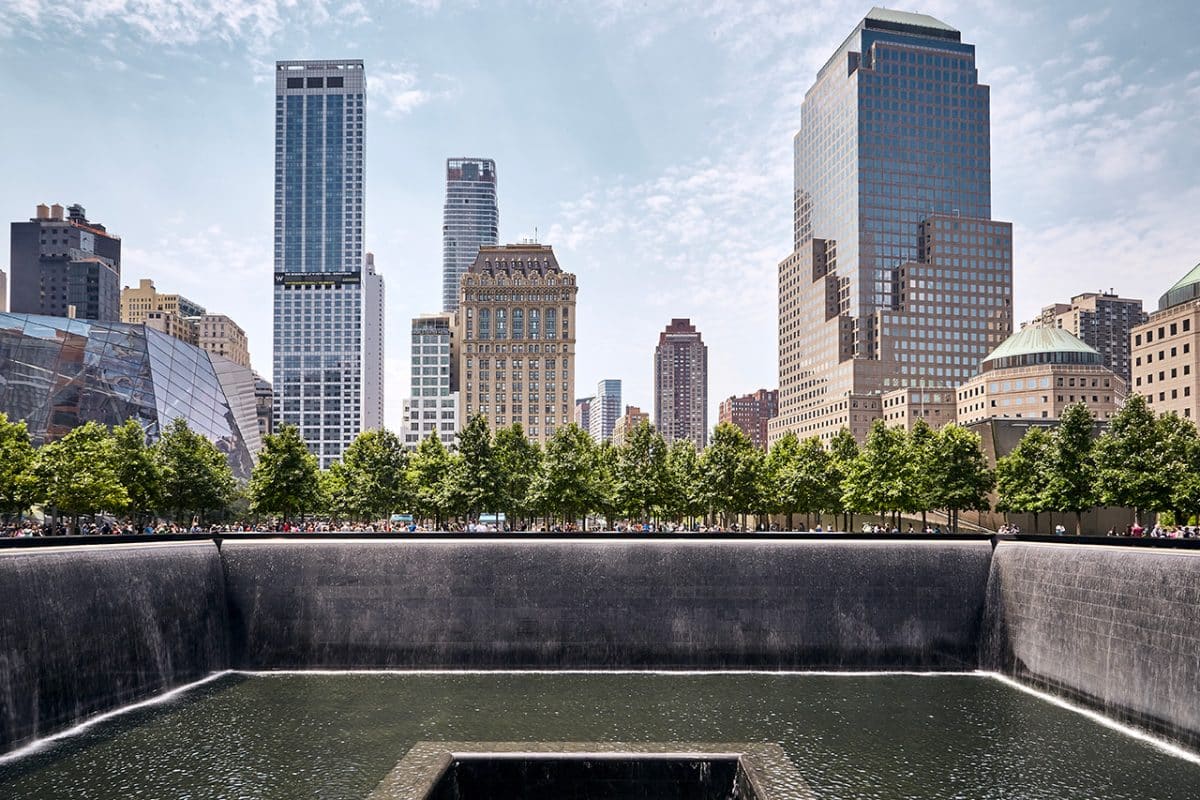
An essential place of remembrance
Visiting the 9/11 Memorial & Museum is a deeply moving experience on any trip to New York. As well as its historical importance, this place offers a space for reflection on the human consequences of the attacks and on how a city and a nation can rebuild after a collective trauma.
The transformation of Ground Zero from a site of destruction to a space of commemoration and rebirth tells a story of resilience that resonates far beyond American borders. For visitors, it is an opportunity to understand how New York has been able to honour its dead while looking to the future, perfectly embodying the indomitable spirit of this extraordinary city.
A visit to the 9/11 Memorial will not leave you unscathed, but will give you a unique perspective on an event that changed the course of contemporary history. Take the time to stop, observe, read the names, and perhaps lay a flower – these small gestures are an integral part of the experience of this place of collective memory.


